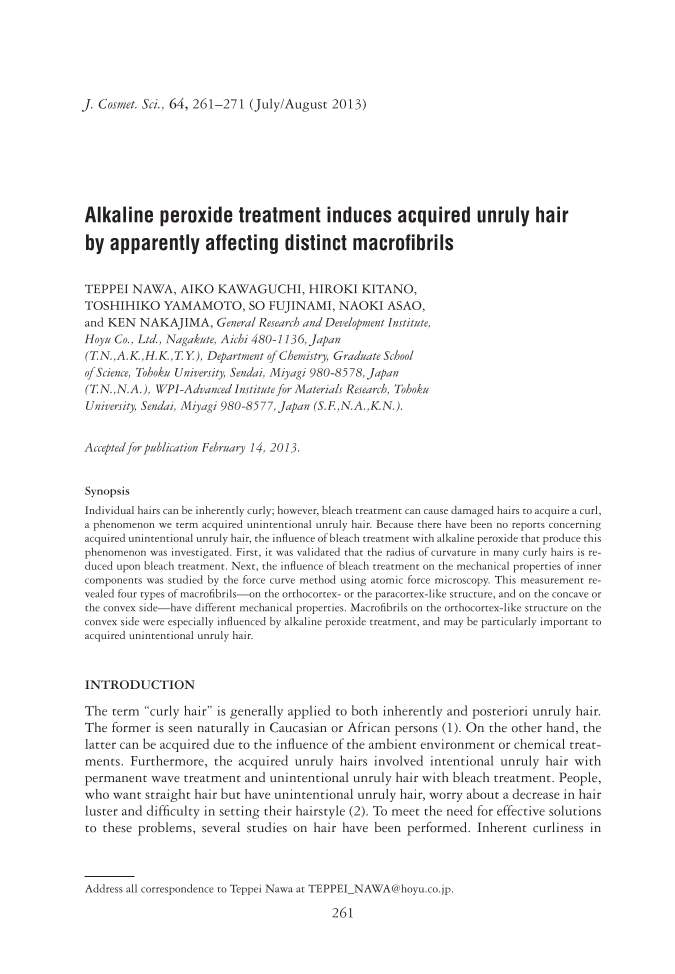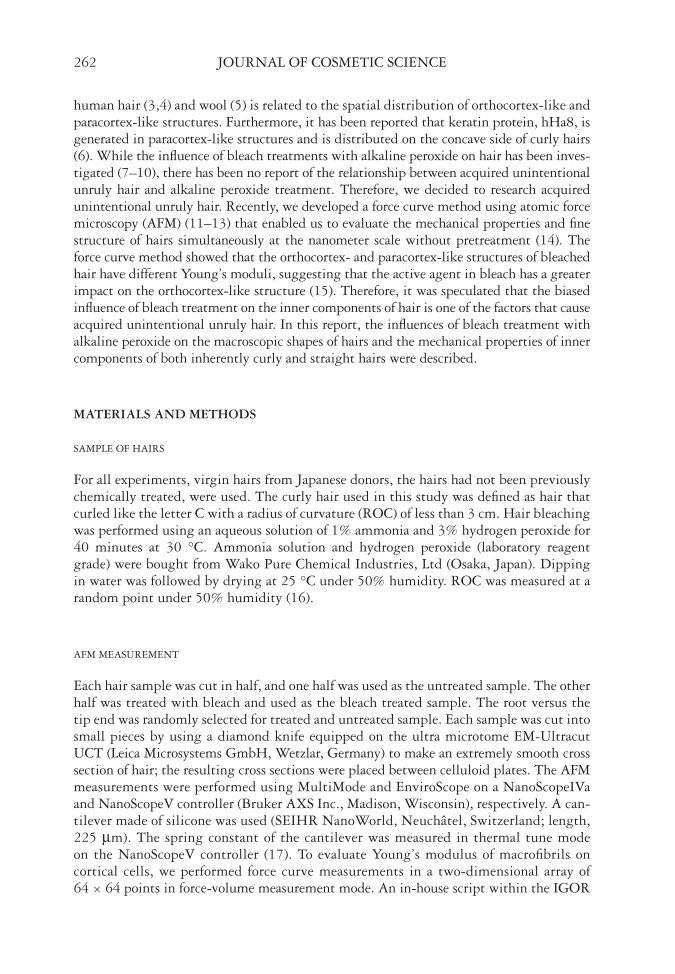J. Cosmet. Sci., 64, 261–271 ( July/August 2013) 261 Alkaline peroxide treatment induces acquired unruly hair by apparently affecting distinct macrofi brils TEPPEI NAWA, AIKO KAWAGUCHI, HIROKI KITANO, TOSHIHIKO YAMAMOTO, SO FUJINAMI, NAOKI ASAO, and KEN NAKAJIMA, General Research and Development Institute, Hoyu Co., Ltd., Nagakute, Aichi 480-1136, Japan (T.N.,A.K.,H.K.,T.Y.), Department of Chemistry, Graduate School of Science, Tohoku University, Sendai, Miyagi 980-8578, Japan (T.N.,N.A.), WPI-Advanced Institute for Materials Research, Tohoku University, Sendai, Miyagi 980-8577, Japan (S.F.,N.A.,K.N.). Accepted for publication February 14, 2013. Synopsis Individual hairs can be inherently curly however, bleach treatment can cause damaged hairs to acquire a curl, a phenomenon we term acquired unintentional unruly hair. Because there have been no reports concerning acquired unintentional unruly hair, the infl uence of bleach treatment with alkaline peroxide that produce this phenomenon was investigated. First, it was validated that the radius of curvature in many curly hairs is re- duced upon bleach treatment. Next, the infl uence of bleach treatment on the mechanical properties of inner components was studied by the force curve method using atomic force microscopy. This measurement re- vealed four types of macrofi brils—on the orthocortex- or the paracortex-like structure, and on the concave or the convex side—have different mechanical properties. Macrofi brils on the orthocortex-like structure on the convex side were especially infl uenced by alkaline peroxide treatment, and may be particularly important to acquired unintentional unruly hair. INTRODUCTION The term “curly hair” is generally applied to both inherently and posteriori unruly hair. The former is seen naturally in Caucasian or African persons (1). On the other hand, the latter can be acquired due to the infl uence of the ambient environment or chemical treat- ments. Furthermore, the acquired unruly hairs involved intentional unruly hair with permanent wave treatment and unintentional unruly hair with bleach treatment. People, who want straight hair but have unintentional unruly hair, worry about a decrease in hair luster and diffi culty in setting their hairstyle (2). To meet the need for effective solutions to these problems, several studies on hair have been performed. Inherent curliness in Address all correspondence to Teppei Nawa at TEPPEI_NAWA@hoyu.co.jp.
JOURNAL OF COSMETIC SCIENCE 262 human hair (3,4) and wool (5) is related to the spatial distribution of orthocortex-like and paracortex-like structures. Furthermore, it has been reported that keratin protein, hHa8, is generated in paracortex-like structures and is distributed on the concave side of curly hairs (6). While the infl uence of bleach treatments with alkaline peroxide on hair has been inves- tigated (7–10), there has been no report of the relationship between acquired unintentional unruly hair and alkaline peroxide treatment. Therefore, we decided to research acquired unintentional unruly hair. Recently, we developed a force curve method using atomic force microscopy (AFM) (11–13) that enabled us to evaluate the mechanical properties and fi ne structure of hairs simultaneously at the nanometer scale without pretreatment (14). The force curve method showed that the orthocortex- and paracortex-like structures of bleached hair have different Young’s moduli, suggesting that the active agent in bleach has a greater impact on the orthocortex-like structure (15). Therefore, it was speculated that the biased infl uence of bleach treatment on the inner components of hair is one of the factors that cause acquired unintentional unruly hair. In this report, the infl uences of bleach treatment with alkaline peroxide on the macroscopic shapes of hairs and the mechanical properties of inner components of both inherently curly and straight hairs were described. MATERIALS AND METHODS SAMPLE OF HAIRS For all experiments, virgin hairs from Japanese donors, the hairs had not been previously chemically treated, were used. The curly hair used in this study was defi ned as hair that curled like the letter C with a radius of curvature (ROC) of less than 3 cm. Hair bleaching was performed using an aqueous solution of 1% ammonia and 3% hydrogen peroxide for 40 minutes at 30 °C. Ammonia solution and hydrogen peroxide (laboratory reagent grade) were bought from Wako Pure Chemical Industries, Ltd (Osaka, Japan). Dipping in water was followed by drying at 25 °C under 50% humidity. ROC was measured at a random point under 50% humidity (16). AFM MEASUREMENT Each hair sample was cut in half, and one half was used as the untreated sample. The other half was treated with bleach and used as the bleach treated sample. The root versus the tip end was randomly selected for treated and untreated sample. Each sample was cut into small pieces by using a diamond knife equipped on the ultra microtome EM-Ultracut UCT (Leica Microsystems GmbH, Wetzlar, Germany) to make an extremely smooth cross section of hair the resulting cross sections were placed between celluloid plates. The AFM measurements were performed using MultiMode and EnviroScope on a NanoScopeIVa and NanoScopeV controller (Bruker AXS Inc., Madison, Wisconsin), respectively. A can- tilever made of silicone was used (SEIHR NanoWorld, Neuchâtel, Switzerland length, 225 μm). The spring constant of the cantilever was measured in thermal tune mode on the NanoScopeV controller (17). To evaluate Young’s modulus of macrofi brils on cortical cells, we performed force curve measurements in a two-dimensional array of 64 × 64 points in force-volume measurement mode. An in-house script within the IGOR
Purchased for the exclusive use of nofirst nolast (unknown) From: SCC Media Library & Resource Center (library.scconline.org)










































































